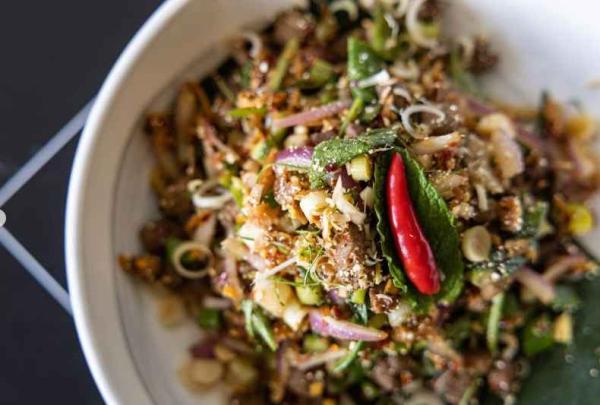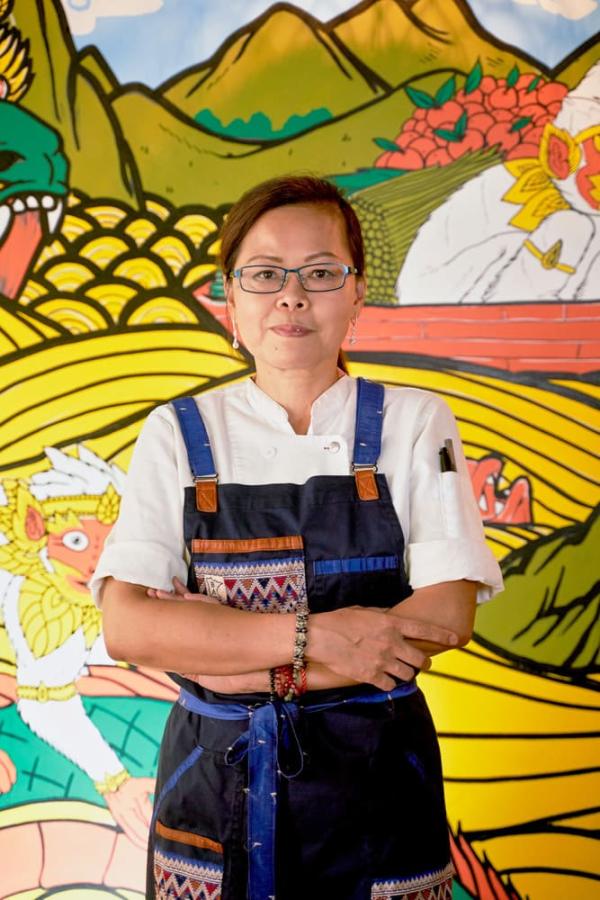
Laab Gai
Serves 2-3
Submited by Chef Seng Luangrath
About the Recipe
If you had to pick one dish to represent Laos, then you probably would think laab. Sometimes spelled larb, this dish is composed of what can be regarded as the flavors of Laos. It is a minced meat dish, seasoned with fresh herbs like cilantro and mint, chilies, a squeeze of lime juice, some fish sauce and an assortment of vegetables, usually whatever is in season. It uses the uniqueness of ground toasted sticky rice powder, khao kua, and kaffir lime leaves to tie it all together.
Laab is traditionally eaten with sticky rice and vegetables. You can find many variations in other parts of Laos and Thailand, using raw meat or raw fish. As with any raw food, it is at your own risk! This dish is served for every gathering, special event, religious ceremonies, and weddings etc. Laab also means and represents blessings, prosperity and good luck!
Chef Seng Luangrath’s traditional Laotian salad, which can be made with chicken, pork, or tofu, is packed with flavor. Sugar and fish sauce lend a slight sweetness, kaffir lime and lemongrass add plenty of aromatic appeal, and lime juice imparts a bright, tangy edge. And then there are the chilies, which can be adjusted to your taste. It can be served with lettuce, cucumber, and cabbage, and, if you go for the bird’s eye chilies, sticky rice helps temper the heat.
Ingredients
- 2 pounds chicken thighs
- 1 teaspoon kosher salt
- 1 tablespoon black pepper, ground
- 1 tablespoon oil (grapeseed or other)
- 2 tablespoons fish sauce or soy sauce
- 1 tablespoon sugar (palm if available)
- 5 tablespoons lime juice
- 1 teaspoon mushroom powder
Sauce
- 1 teaspoon kosher salt
- 1 teaspoon toasted sticky rice powder
- 1 tsp dried red bird-eye chili powder
- ½ cup mint leaves
- ½ cup cilantro leaves
- ½ cup rau ram leaves
- ½ cup green onion, chopped
- ¼ cup lemongrass stalks, thinly sliced
- 1 tablespoon makrut lime leaves, thinly sliced
- 1 tablespoon galangal, thinly sliced
- 2 tablespoons fried shallot
- 2 tablespoons fried garlic
Directions
Toasted Sticky Rice Powder
- Place raw sticky rice in a non-stick sauté pan over high heat. Using a wooden spoon, stir the rice occasionally until the grains are dark golden brown and the aromas become intensely smokey. If some grains are burnt or blackened, that is acceptable.
- After the toasting is completed, transfer them to a baking sheet and spread the grains in an even layer to cool completely at room temperature.
- Once cooled, grind to a fine coarse texture using a mortar and pestle, food processor, or blender.
- Transfer to an airtight container and store in your pantry for up to six months.
Chicken
- Preheat the oven to 350°F.
- While the oven is heating, marinate the chicken thighs with kosher salt, black pepper, and grapeseed oil.
- Place on a baking sheet with a baking rack and bake for around 20-25 minutes or until the internal temperature is 165°F.
- Allow to cool completely at room temperature. Shred or chop the chicken and set aside.
Sauce
Whisk all of the ingredients in a small mixing bowl until well combined. Set aside.
To Assemble
In a medium sized mixing bowl, combine the chicken and sauce together until well incorporated. Add in the remaining garnishes and carefully toss all together. Serve with sticky rice.
Notes
- The main protein for this recipe can be substituted for different alternatives such as pork, seafood, tofu, or vegetables. It can be prepared in many different ways such as grilled, fried, steamed, poached or even raw similar to ceviche.
- If mushroom powder is unavailable, you can grind dried shiitake or any mushrooms into a powder using a spice grinder or blender. Another option would be sea salt.
- If dried red bird-eye chili powder is unavailable in your local stores, you can opt for cayenne powder, paprika, crushed chili flake, or even fresh chilies such as jalapenos.
- If rau ram (Vietnamese coriander) is unavailable, it is not mandatory and can be left out. If fresh lemongrass is unavailable, you can find frozen grated lemongrass in the freezer aisle in asian supermarkets.
- If makrut lime leaves are unavailable, freshly grated lime peel can be substituted.
- If galangal is unavailable, you can replace it with fresh ginger.
- If fried shallots are unavailable, you can replace them with fresh thinly sliced shallots.
- If fried garlic is unavailable, you can opt it out.
About the Contributor
Chef Seng was born in Laos and fled the country during the Vietnam War. During her stay in the Thailand refugee camp of Nakhon Phanom, she learned how to cook from her camp neighbors and elders. At the age of 12, she was the eldest of five and took on the role of caretaker of her siblings in order to support her working mother.
In 2009, at age 40, she pursued her passion for cooking, taking over Padaek (formerly Bangkok Golden) in 2010, where she gradually introduced her own Lao dishes. In 2014, she opened Thip Khao a Lao restaurant in Columbia Heights and home of the Lao Food Movement. Thip Khao has earned accolades, including being named one of the top 50 new restaurants in the US by Bon Appetit Magazine and Michelin Bib Gourmand. Chef Seng and Thip Khao were also featured on an episode of Somebody Feed Phil Season 7, a Netflix Original series.



